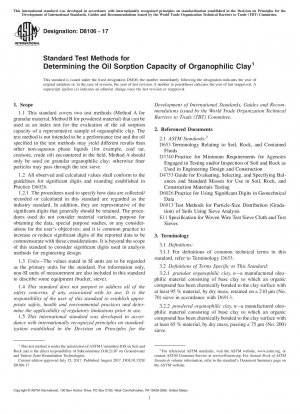ASTM D8106-17
Standard Test Methods for Determining the Oil Sorption Capacity of Organophilic Clay
- Standard No.
- ASTM D8106-17
- Release Date
- 2017
- Published By
- American Society for Testing and Materials (ASTM)
- Latest
- ASTM D8106-17
- Scope
-
5.1 This standard test method is intended as an index test to determine the relative oil sorption capacity of an organophilic clay. Organophilic clay is used for remediation of contaminated sediment, soil, and groundwater. Results of this standard test method can be used for a) evaluating whether product meets a manufacturing quality control specification, and b) evaluating acceptance of a product per a construction quality assurance material specification. The organophilic clay specified may be either granular or powder. There are two test methods; a gravity test method for granular specimens and a centrifuge test method for powdered specimens.
Note 1: The quality of the result produced by this standard is dependent on the competence of the personnel performing it, and the suitability of the equipment and facilities used. Agencies that meet the criteria of Practice D3740 are generally considered capable of competent and objective testing/sampling/inspection/etc. Users of this standard are cautioned that compliance with Practice D3740 does not in itself assure reliable results. Reliable results depend on many factors; Practice D3740 provides a means of evaluating some of those factors.
1.1 This standard covers two test methods (Method A for granular material, Method B for powdered material) that can be used as an index test for the evaluation of the oil sorption capacity of a representative sample of organophilic clay. The test method is not intended to be a performance test and the oil specified in the test methods may yield different results than other non-aqueous phase liquids (for example, coal tar, creosote, crude oil) encountered in the field. Method A should only be used on granular organophilic clay; otherwise finer particles may pass through the test sieve.
1.2 All observed and calculated values shall conform to the guidelines for significant digits and rounding established in Practice D6026.
1.2.1 The procedures used to specify how data are collected/recorded or calculated in this standard are regarded as the industry standard. In addition, they are representative of the significant digits that generally should be retained. The procedures used do not consider material variation, purpose for obtaining the data, special purpose studies, or any considerations for the user’s objectives; and it is common practice to increase or reduce significant digits of the reported data to be commensurate with these considerations. It is beyond the scope of this standard to consider significant digits used in analysis methods for engineering design.
1.3 Units—The values stated in SI units are to be regarded as the primary units for the standard. For information only, non-SI units of measurement are also included in this standard to describe some equipment (bucket, sieve).
1.4 This standard does not purport t......
ASTM D8106-17 Referenced Document
- ASTM D3740 Standard Practice for Minimum Requirements for Agencies Engaged in the Testing and/or Inspection of Soil and Rock as Used in Engineering Design and Construction
- ASTM D4753 Standard Specification for Evaluating, Selecting, and Specifying Balances and Scales for Use in Soil, Rock, and Construction Materials Testing
- ASTM D6026 Standard Practice for Using Significant Digits in Geotechnical Data
- ASTM D653 Standard Terminology Relating to Soil, Rock, and Contained Fluids
- ASTM D6913 Standard Test Methods for Particle-Size Distribution (Gradation) of Soils Using Sieve Analysis
- ASTM E11 Standard Specification for Wire Cloth and Sieves for Testing Purposes
ASTM D8106-17 history
- 2017 ASTM D8106-17 Standard Test Methods for Determining the Oil Sorption Capacity of Organophilic Clay

Copyright ©2024 All Rights Reserved